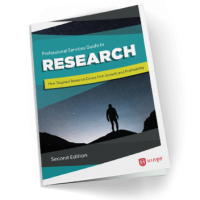How do clients and prospects view my firm’s brand? What are we known for in the marketplace? Why are we more – or less – visible than the firms we’re competing against?
These are common questions professional services firms ask when evaluating their brand. The answers can come directly from the individuals exposed to your brand every day – your clients, prospects, referral sources, influencers, and even your own internal staff.
However, uncovering their true perspective on your brand is no easy task. If you decide to research your target audience, the type of research you do can affect the insights you get back. The decisions you make early in researching your brand can uncover truths… or they can lead you down the wrong path.
Particularly for professional services firms, there are two common methods to conducting research: online surveys and in-depth interviews (IDIs). It is essential to understand the benefits and drawbacks to each method so that your firm can determine which one, or combination of the two, is best for your firm.
Online Surveys—Benefits & Drawbacks
What are the benefits of an online survey?
- They cost less. While they do require some maintenance and monitoring during the data collection period,online surveys allow you to capture a high volume of responses for less money.
- They can save time. Usually, respondents can complete an online survey faster than if they participated in an IDI (typically, a phone interview). Additionally, finding a time that fits the interviewer’s and respondent’s schedule can be a challenge. Online surveys are flexible and can be accessed at the respondent’s convenience.
- They allow you to sample a larger, more representative population. If your firm has 40,000 clients, interviewing all 40,000 would not be feasible. With an online survey, you have the ability to capture the responses of a more representative sample, if not the entire population.
What are the drawbacks of online surveys?
- They may require incentives. Depending on your circumstances, the audience that you are trying to reach may not be inclined to take your survey out of goodwill. Some respondents may want something in return for taking the time to complete your survey. Incentives might include exclusive access to the results of your research, but you might have to resort to old-fashioned bribery. Gift cards with broad appeal (like Starbucks, iTunes, or Amazon) can be effective incentives.
- Many will go uncompleted. Online survey respondents don’t always answer every question on a survey. Sometimes, they will exit the survey before completing it. There are a number of factors that impact completion rate, soy building a strong questionnaire is important.
- Harder to get detail or explanation. Most survey respondents opt not to type out detailed, explanative responses. Because of this, open-ended questions are difficult to ask in survey format. Instead, closed-ended “select all that apply” questions may be used to keep the respondent engaged and prevent a high drop-off rate. Unfortunately, this practice prevents respondents from using their natural language when answering questions.
In-Depth Interviews (IDIs)—Benefits & Drawbacks
What are the benefits of in-depth interviews?
- You never know what you may uncover. A talented interviewer can dive deep into specific topics and adjust their line of questioning based on the direction of the interview. When done correctly, this sort of probing can uncover perspectives that may have never been considered or addressed by your firm. These unknown perspectives are very difficult to uncover in an online survey, where responses are confined to a predetermined set of questions and answer choices. These surprise insights can be the most valuable things you learn from your research.
- Your participants can speak candidly about you. Having a third party conduct interviews will make interviewees feel more comfortable expressing their true feelings and opinions. A talented interviewer can make an IDI feel more like a friendly conversation than an interrogation.
- You’re more likely to get a higher response rate. Persistence in scheduling the interview and dealing with potential respondents individually contributes to a higher response rate for IDIs compared to online surveys. This high response rate allows you to more accurately forecast the number of respondents, as well as how long it will take to complete the data collection.
What are the drawbacks of IDIs?
- You’ll need experienced interviewers. The benefits of conducting IDIs hinge on the experience of the interviewer. An experienced interviewer will know when to probe for more detail, recall answers earlier in the interview that might be applicable to questions further down the line, and take detailed notes for subsequent data processing and coding. All of these skills are essential to get the most from your IDIs.
- It can take time and money. Hiring an experienced interviewer to conduct the interviews has many positive benefits, but it can be an expensive investment. Also, scheduling and completing interviews can be time consuming. Make sure you know when conducting an interview is appropriate, and when other data collection methods are a more suitable alternative.
- Limited sample sizes. Because of the time and costs associated with IDIs, you may have to limit the size of your sample. Depending on your budget and the size of the overall population you are sampling, an IDI may or may not be the right fit.
Which Method Should You Use?
What’s the best data collection method to conduct primary research on your firm’s brand? That depends on the population you want to examine.
For example, if the population is smaller, highly targeted, and needs to meet specific criteria, then IDIs are likely to be the best route to understand that population.
On the other hand, an online survey may be more suitable if you want to sample a larger population—such as your total client base or hundreds of your firm’s employees.
By the way, it can be valuable to get a sense of how internal staff views the firm’s brand. This can lay the groundwork for uncovering gaps in perception between your internal staff and clients, prospects, and referral sources.
It’s not uncommon for clients to view one aspect of a firm favorably, while your staff completely fail to appreciate it. Connecting these dots can unify your brand message and highlight what clients truly value in working with your firm.
An Integrated Approach
These two data collection instruments aren’t mutually exclusive. Using a hybrid of these two approaches can be effective. For instance, pairing IDIs of external audiences (clients, prospects, lost prospects) with an online survey of your internal population (employees, senior management, key stakeholders) can yield the qualitative and quantitative insights you need to produce valuable, actionable results.
Another integrated method uses a two-phase approach. In phase one,the “discovery” phase, a limited number of IDIs (say 3-6) are conducted with members of your external audience to uncover salient trends, topics, or viewpoints. In phase two, the “validation phase”, the IDI responses are used to construct a survey that validates the findings from phase one using a much larger and statistically representative sample. Two-phase approaches are a great way to uncover and validate viewpoints of your brand or industry, but this approach can be expensive and time consuming. Generally, a two-phase approach is used when conducting research on your industry.*
It is important to keep in mind how decisions made early on in the research process can have a profound impact on results—and ultimately your firm’s brand strategy.
Think of research like the foundation of a house. If poorly constructed, your house may only be sturdy for a short while. If done properly, it can have an enduring impact on your firm’s success.
*This sort of research can have a valuable double life. You can repurpose it as “research as content” to build visibility and credibility with your target audience.
How Hinge Can Help
Brand research gets to the core of what will resonate with those audiences—and is an integral part of what Hinge does for clients. Learn more about our research services or contact us to learn whether research makes sense for your professional services firm.
Additional Resources
- Our Professional Services Guide to Research will show you how to use research to build a smarter, more competitive firm.
- To understand how your buyers think and why they choose one professional services firm over another, check out our full-length book, Inside the Buyer’s Brain: How to Turn Buyers into Believers.
- Bring data-driven marketing to your firm with Hinge University’s step-by-step, in-depth courses.





